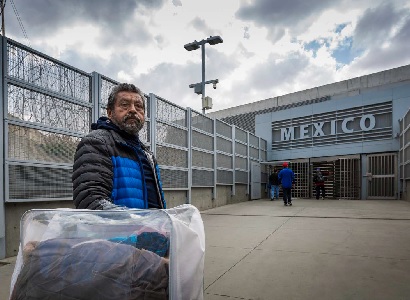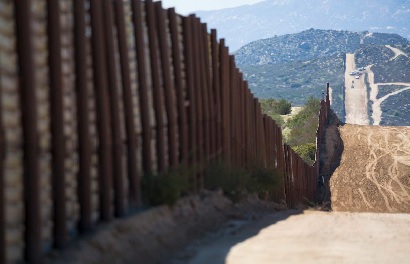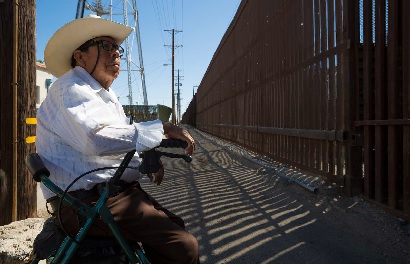At the time of the walls
Publish date 29-03-2023
 The watchword is to resist. To the nerve-racking wait at the border. Hostage of the political battle between the Democratic administration and the Republican opposition. Tens of thousands of Latin American refugees are herded into cities near the Mexico-US border in the hope that the latter will waive the so-called "Title 42". This is the complete ban on entry and the possibility of express expulsions of asylum seekers, decided by Donald Trump at the time of the pandemic and still in force. On December 20, on the eve of the expiry of the latest extension, the Supreme Court decided to stall due to pressure from 19 conservative governors who fear a new wave of arrivals. At least until January, therefore, the ban will not be abolished.
The watchword is to resist. To the nerve-racking wait at the border. Hostage of the political battle between the Democratic administration and the Republican opposition. Tens of thousands of Latin American refugees are herded into cities near the Mexico-US border in the hope that the latter will waive the so-called "Title 42". This is the complete ban on entry and the possibility of express expulsions of asylum seekers, decided by Donald Trump at the time of the pandemic and still in force. On December 20, on the eve of the expiry of the latest extension, the Supreme Court decided to stall due to pressure from 19 conservative governors who fear a new wave of arrivals. At least until January, therefore, the ban will not be abolished.
 In the meantime, the tens of thousands of women and men from the rest of the continent – the Central Americans were joined above all by Venezuelans and Haitians – just have to wait. And resist. Made increasingly difficult now that the night temperature is close to ten degrees below zero. In Ciudad Juárez, shelters are congested. Seven hundred people, therefore, camped under the bridge along the Rio Bravo but the makeshift tent city was cleared out before Christmas. Many, therefore, have decided to immerse themselves in the frozen water and cross the river irregularly to pass into the twin El Paso. In the first half of December, intentions to enter the USA grew exponentially, together with the prices of "coyotes", human traffickers specialized in circumventing controls. Some days there were as many as 2,500, so much so that finally, on December 19, Governor Greg Abbott deployed the National Guard to lock down the border, already controlled by 23,000 federal agents. Those who managed to reach El Paso, Texas, before that day, however, did not find a better situation. In the US town the risk of being intercepted is too high to take a bus and go to other destinations. Or even just to knock on a service center door.
In the meantime, the tens of thousands of women and men from the rest of the continent – the Central Americans were joined above all by Venezuelans and Haitians – just have to wait. And resist. Made increasingly difficult now that the night temperature is close to ten degrees below zero. In Ciudad Juárez, shelters are congested. Seven hundred people, therefore, camped under the bridge along the Rio Bravo but the makeshift tent city was cleared out before Christmas. Many, therefore, have decided to immerse themselves in the frozen water and cross the river irregularly to pass into the twin El Paso. In the first half of December, intentions to enter the USA grew exponentially, together with the prices of "coyotes", human traffickers specialized in circumventing controls. Some days there were as many as 2,500, so much so that finally, on December 19, Governor Greg Abbott deployed the National Guard to lock down the border, already controlled by 23,000 federal agents. Those who managed to reach El Paso, Texas, before that day, however, did not find a better situation. In the US town the risk of being intercepted is too high to take a bus and go to other destinations. Or even just to knock on a service center door.
 On Christmas Eve, Abbott intercepted 130 refugees - mostly families with children -, loaded them onto buses and sent them to Washington, in front of the residence of Vice President Kamala Harris. A sign of protest against the migration policy of the White House, just as already experienced in October. The refugees of El Paso – in October alone, the last month for which data are available, there were 50,000 – live like shadows. They do the same in Brownsville, 1,300 kilometers east along the course of the Rio Bravo, on the border with the Mexican Matamoros. Not far from the latter, in Reynosa, four thousand people sleep in organized tent cities.
On Christmas Eve, Abbott intercepted 130 refugees - mostly families with children -, loaded them onto buses and sent them to Washington, in front of the residence of Vice President Kamala Harris. A sign of protest against the migration policy of the White House, just as already experienced in October. The refugees of El Paso – in October alone, the last month for which data are available, there were 50,000 – live like shadows. They do the same in Brownsville, 1,300 kilometers east along the course of the Rio Bravo, on the border with the Mexican Matamoros. Not far from the latter, in Reynosa, four thousand people sleep in organized tent cities.
The danger here, in addition to freezing and starvation, are the narcos. Kidnapping trapped migrants to extort money from them or resell them in the thriving market in organs, slave labor or forced prostitution is an easy business for the large Mexican mafias that control the territory. Nobody knows how many of the refugees are kidnapped, since people don't report. Humanitarian organizations, however, are alarmed. Many try to exercise informal vigilance. The migrants themselves have created an informal supervisory network. Difficult, however, win over the narcos. The refugees in limbo just have to try to make themselves invisible.
Waiting for the doors of the US to finally reopen. Even just to accept asylum applications.
Max Ferrero and Renata Busettini
(texts by Lucia Capuzzi)
NP January 2023







